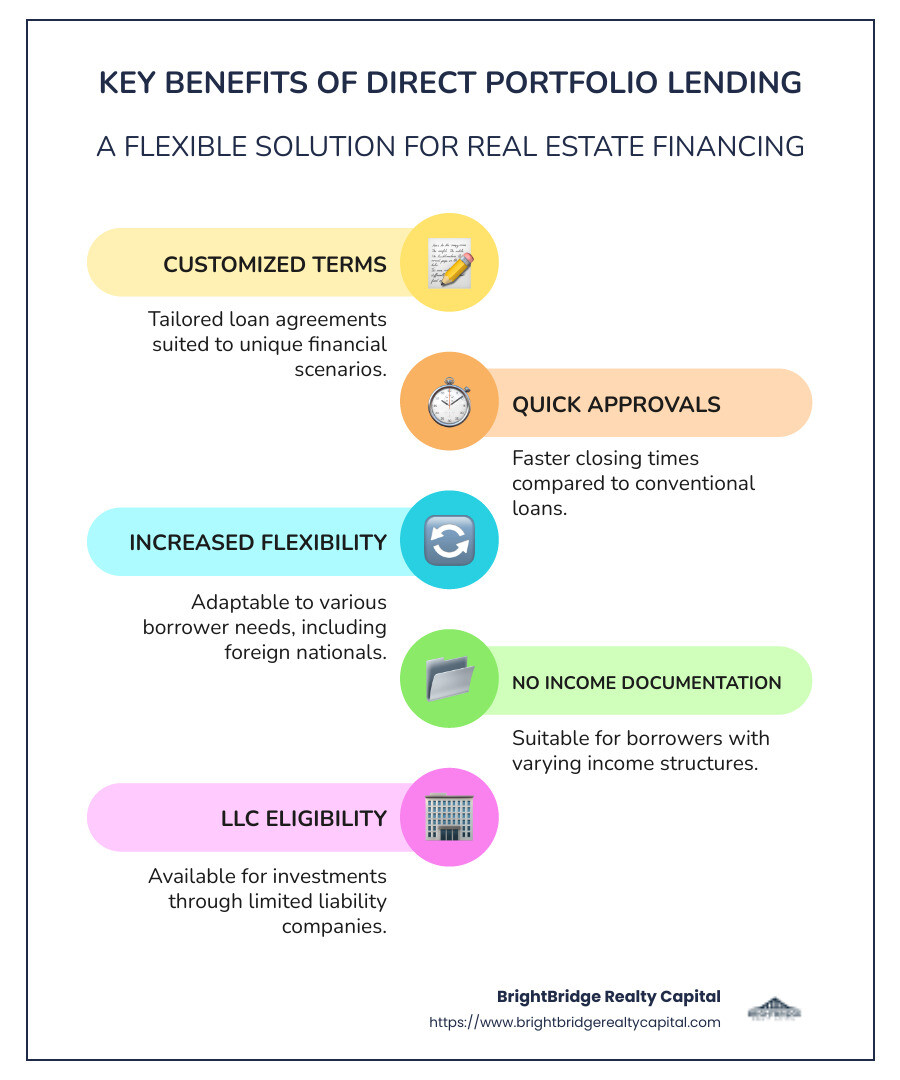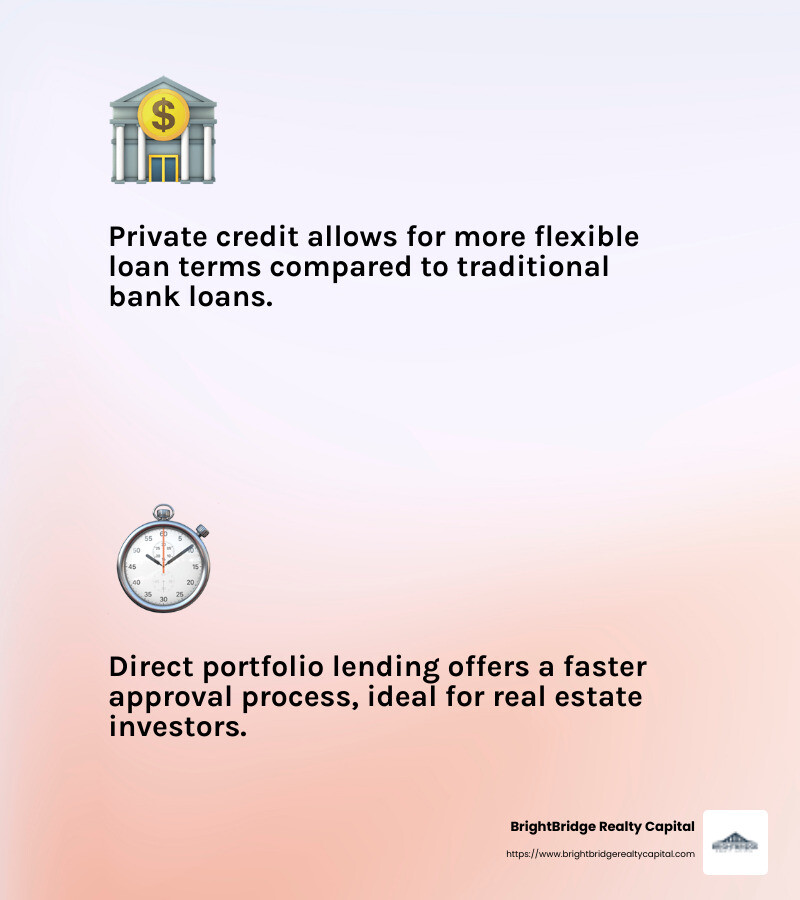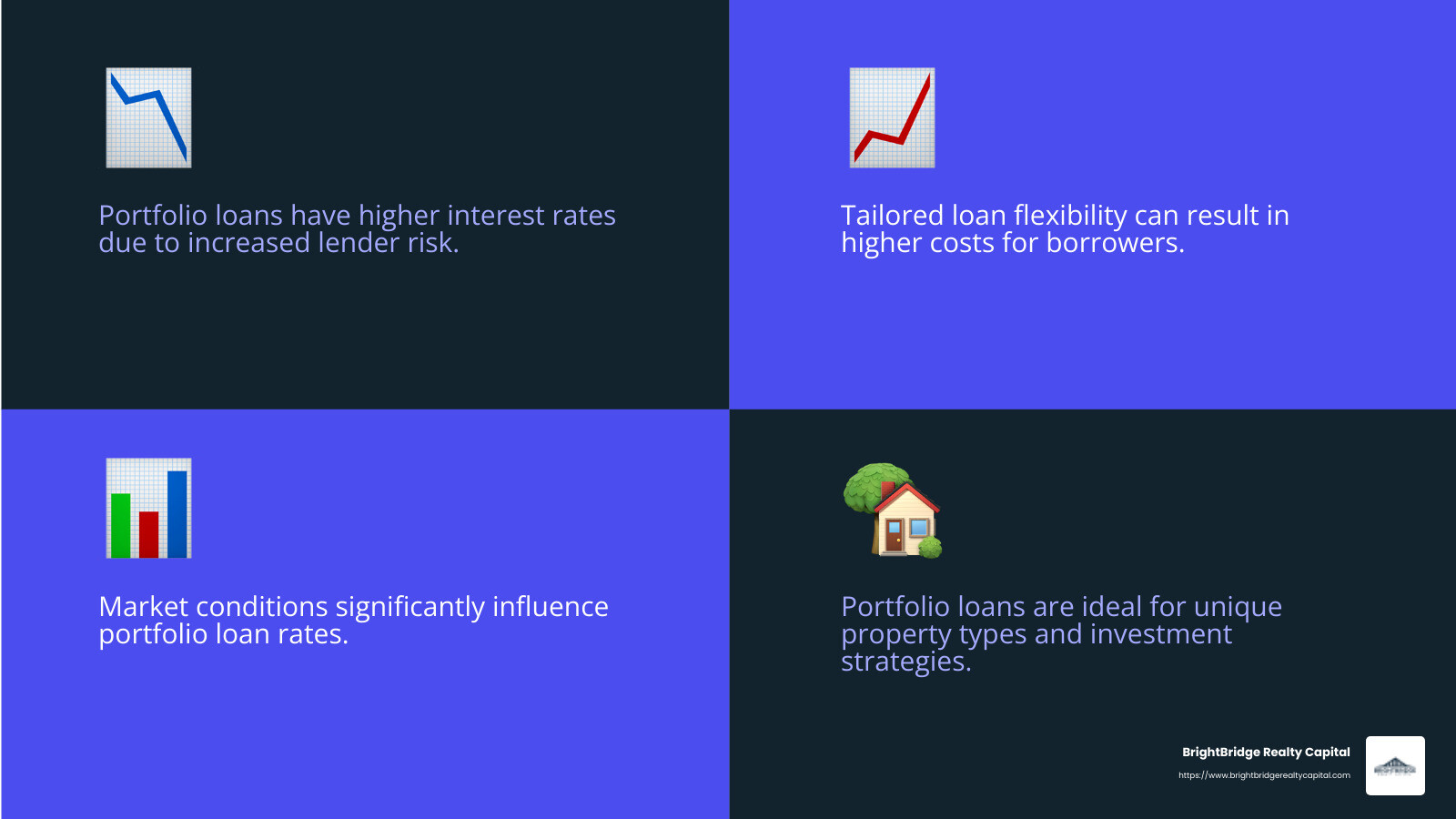The Ins and Outs of Direct Portfolio Lending

Direct portfolio lending has become an essential tool for real estate investors seeking quick and flexible financial solutions. It serves as a direct bridge between lenders and borrowers, offering customized loan options outside the traditional confines of conventional mortgages. Here's a quick overview:
What is Direct Portfolio Lending?
- A method where loans are retained in the lender’s portfolio, providing more flexibility.
- Typically involves more personalized terms compared to typical bank loans.
Why it Matters in Real Estate Financing?
- Ideal for investors with unique financial needs or those looking to expand their portfolios rapidly.
- Offers faster closing times, crucial in competitive markets.
In today’s real estate market, the traditional loan process can often be a hurdle. That's where direct portfolio lending steps in. With the power to streamline loan approval processes and customize loan terms, it provides a vital lifeline for investors needing timely and flexible funding.
Why stick with the status quo when you can tap into a more custom and expedient financing solution?

Simple guide to direct portfolio lending terms:
- commercial real estate portfolio loans
- portfolio loans real estate
- real estate loan portfolio analysis
Understanding Direct Portfolio Lending
Direct portfolio lending is a unique approach to financing that allows lenders to keep loans on their books rather than selling them in the secondary market. This strategy gives lenders the flexibility to set more personalized loan terms, making it a popular choice for real estate investors who need quick and adaptable financial solutions.
The Role of Private Credit
Private credit plays a crucial role in direct portfolio lending. Unlike traditional bank loans, which are often constrained by regulatory standards and lengthy approval processes, private credit offers a more streamlined and flexible approach.

Flexibility and Speed: Private credit allows for faster loan approvals and more flexible terms, which is vital in a competitive real estate market. This flexibility makes it easier for investors to seize opportunities without delay.
Customization: Lenders can tailor loans to meet the specific needs of borrowers, accommodating unique financial situations or investment strategies.
Investment Strategy Insights
For investors, direct portfolio lending offers a strategic advantage. Here's why:
Diversification: By including direct portfolio loans in their investment mix, investors can diversify their portfolios and reduce risk. This approach can be particularly beneficial in volatile markets where traditional investments may not perform well.
Improved Returns: The ability to negotiate terms directly with lenders can lead to better interest rates and repayment schedules, potentially enhancing overall returns on investment.
Access to Capital: Investors can access capital more quickly than through conventional loans, allowing them to act swiftly on lucrative real estate deals.
Direct portfolio lending is not just about obtaining a loan; it's about leveraging a strategic financial tool that aligns with the dynamic needs of modern real estate investing. With its personalized approach and the backing of private credit, it empowers investors to steer the complexities of the real estate market with greater confidence and agility.
Key Features of Direct Portfolio Loans
Direct portfolio loans offer distinct features that cater to the diverse needs of real estate investors. Let's explore some of the standout characteristics that make these loans a compelling choice:
No Income Documentation
One of the most attractive features of direct portfolio lending is the absence of income documentation requirements. Traditional loans often demand extensive proof of income, which can be a hurdle for investors with complex financial situations or those who prefer privacy.
For example, real estate investors who reinvest their profits instead of drawing a regular salary benefit from this feature. By eliminating the need for income verification, direct portfolio loans streamline the application process, making it faster and less cumbersome.
Eligibility for Foreign Nationals
Foreign nationals often face challenges when seeking real estate financing in the U.S. However, direct portfolio loans offer a solution by opening doors to international investors. These loans don't require U.S. citizenship, allowing foreign nationals to invest in American real estate without the typical barriers.
This feature is particularly beneficial for global investors looking to diversify their portfolios with U.S. properties, as it provides access to a lucrative market without the usual red tape.
LLC Eligibility
Investing through a Limited Liability Company (LLC) can offer significant advantages, such as liability protection and potential tax benefits. Direct portfolio loans accommodate this by allowing borrowers to close loans in the name of an LLC.
This flexibility is crucial for investors who prefer to structure their real estate holdings through an LLC, providing them with a custom financing option that aligns with their business strategy.
These key features of direct portfolio loans—no income documentation, eligibility for foreign nationals, and LLC eligibility—highlight the adaptability and investor-friendly nature of this financing option. By addressing unique needs and reducing bureaucratic problems, these loans empower investors to focus on growing their real estate portfolios efficiently.
Benefits and Drawbacks of Direct Portfolio Lending
Direct portfolio lending offers a unique set of advantages and disadvantages that real estate investors should consider. Understanding these can help you decide if this financing option aligns with your investment strategy.
Pros of Direct Portfolio Lending
1. Competitive Rates:
While portfolio loans may sometimes come with higher interest rates due to the lender's inability to resell the loan, they can also offer competitive rates custom to your financial situation. This flexibility can be particularly appealing if your credit history is less than perfect or if you have significant assets but irregular income.
2. Seamless Process:
The streamlined process of direct portfolio lending is a major benefit. With fewer documentation requirements, such as no need for income verification, the application and approval process is quicker and less stressful. This efficiency is a boon for investors who need to move fast to secure a property.
3. Personalized Service:
Many portfolio lenders are community banks that offer a more personalized service. This can mean better customer care and a willingness to find creative solutions custom to your needs. The hands-on approach can be a significant advantage if you value a close relationship with your lender.
Cons of Direct Portfolio Lending
1. Higher Interest Rates:
One downside is the potential for higher interest rates. Since lenders cannot sell these loans on the secondary market, they might charge more to offset the risk. This can increase your overall borrowing costs compared to conventional loans.
2. Higher Fees:
In addition to interest rates, you might encounter higher fees. Lenders may impose these to compensate for the additional risk they take on with portfolio loans. It's crucial to review all fees associated with the loan to ensure they align with your financial goals.
3. Some Standards Still Apply:
Although direct portfolio loans are more flexible, some lenders may still require you to meet certain standards if they plan to sell the loan in the future. This means you might still need to meet some traditional underwriting requirements.
In summary, direct portfolio lending provides flexibility and a streamlined process, making it an attractive option for many real estate investors. However, weigh these benefits against potential higher costs and fees to determine if it's the right fit for your investment strategy.
Direct Portfolio Lending vs. Conventional Loans
When it comes to financing real estate, understanding the differences between direct portfolio lending and conventional loans can help you make informed decisions.
Portfolio Loan vs. Conventional Loan
Direct Portfolio Lending:
- Flexibility: Portfolio loans are known for their flexibility. They cater to borrowers with unique financial situations, such as those with irregular income or significant assets but lower credit scores. This adaptability makes them a go-to option for investors who may not meet the typical criteria for conventional loans.
Streamlined Process: The application process for direct portfolio loans is often quicker and less cumbersome. With fewer documentation requirements—like no need for income verification—borrowers can secure financing without the usual hassle.
Personalized Service: Many portfolio lenders are local banks or smaller institutions offering personalized service. This can result in more creative financing solutions and a closer working relationship with your lender.
Conventional Loans:
- Lower Interest Rates: Conventional loans typically offer lower interest rates. Since these loans can be sold on the secondary market, lenders face less risk and can afford to offer more competitive rates.
Standardized Process: The process for obtaining a conventional loan is more standardized. This means more documentation, such as proof of stable income and a higher credit score, is required. However, this can also mean a more predictable process and outcome.
Wider Availability: Conventional loans are widely available and are often the first choice for borrowers with stable income and good credit. They are backed by government-sponsored entities like Fannie Mae and Freddie Mac, which provides added security to lenders.
Mortgage Comparison
| Feature | Direct Portfolio Loan | Conventional Loan |
|---|---|---|
| Interest Rates | Potentially higher | Typically lower |
| Flexibility | High (custom to borrower needs) | Low (standard criteria) |
| Documentation | Minimal (no income verification) | Extensive (proof of income required) |
| Service | Personalized (local lenders) | Standardized (larger institutions) |
| Availability | Limited (specific lenders) | Widely available (backed by government) |
Direct portfolio lending and conventional loans each have their place in real estate financing. The choice between them depends on your financial situation, investment goals, and the level of flexibility you need. Understanding these differences will help you choose the right path for your real estate ventures.
Frequently Asked Questions about Direct Portfolio Lending
What are the requirements for a portfolio loan?
Portfolio loans are known for their flexibility. Unlike conventional loans, the requirements can vary greatly from one lender to another. Here's a quick breakdown:
Credit Score: Some lenders are willing to work with lower credit scores. For instance, you might find a lender accepting scores as low as 580, while others might require a minimum of 640 or even 700 if there’s no down payment.
Down Payment: Requirements can also differ, but generally, a higher down payment might be needed compared to conventional loans.
Income Documentation: One of the unique features is that some portfolio loans don't require income documentation. This can be a huge advantage for self-employed borrowers or those with irregular income streams.
Property Type: These loans can also be used for unique property types or investment strategies, like purchasing properties under an LLC or even for foreign nationals.
Can you refinance a portfolio loan?
Yes, refinancing a portfolio loan is possible. The process, however, might differ from refinancing a conventional loan. Here’s what you need to consider:
Loan Terms: Refinancing terms will depend on the lender. Some lenders may offer more flexible terms to adjust to your current financial situation or to take advantage of lower interest rates.
Costs and Fees: Be aware of potential prepayment penalties or fees associated with refinancing. It's crucial to weigh these costs against the benefits of refinancing.
Interest Rates: Refinancing can be a great opportunity to secure a better interest rate. However, rates for portfolio loans are generally higher than conventional loans, so ensure the new rate offers a significant benefit.
What are the typical rates for portfolio loans?
Interest rates for portfolio loans tend to be higher than those for conventional loans. Here's why:
Risk Factor: Since portfolio loans don't adhere to the conforming standards set by Fannie Mae and Freddie Mac, they present a higher risk to lenders. This risk is often offset by higher interest rates.
Customization and Flexibility: The ability to tailor loans to unique borrower needs comes at a cost. In exchange for this flexibility, lenders typically charge higher rates.
Market Conditions: Like all loans, portfolio loan rates are influenced by broader market conditions. It's wise to stay informed about market trends to understand potential rate fluctuations.

Understanding the nuances of direct portfolio lending can help you steer the complexities of real estate financing. Whether you’re considering a portfolio loan for its flexibility or exploring refinancing options, knowing the ins and outs will empower you to make informed decisions.
Conclusion
In real estate financing, direct portfolio lending offers a unique and flexible solution. At BrightBridge Realty Capital, we specialize in providing customized financing solutions custom to meet the needs of our clients. Our approach is centered around delivering fast closings and a seamless process, ensuring that you can seize investment opportunities without delay.
One of the standout features of working with us is our commitment to fast closings. We understand that timing is crucial in the real estate market. That's why we strive to close deals often within a week. This speed is possible because we are a direct lender, eliminating the need for intermediaries and allowing us to offer competitive rates.
Moreover, our customized solutions mean that we work closely with you to understand your specific needs and goals. Whether you are investing in a fix-and-flip project, ground-up construction, or a rental property, we provide the flexibility and support you need to succeed. Our team of experts is dedicated to managing every detail, from the initial application to the final payoff, ensuring a smooth and hassle-free experience.
Explore the possibilities with BrightBridge Realty Capital. Let us help you bridge the gap with smart real estate financing solutions that keep your investment strategy moving forward.


